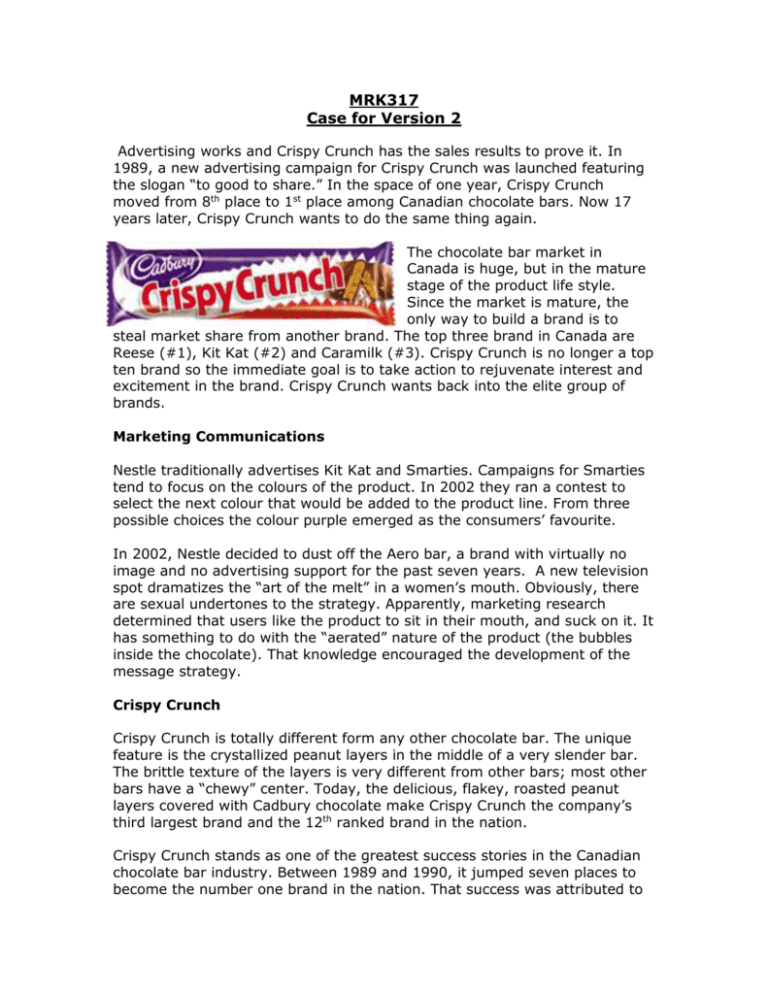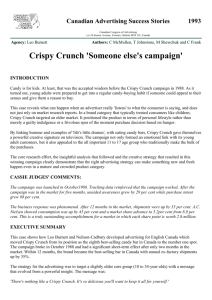
MRK317
Case for Version 2
Advertising works and Crispy Crunch has the sales results to prove it. In
1989, a new advertising campaign for Crispy Crunch was launched featuring
the slogan “to good to share.” In the space of one year, Crispy Crunch
moved from 8th place to 1st place among Canadian chocolate bars. Now 17
years later, Crispy Crunch wants to do the same thing again.
The chocolate bar market in
Canada is huge, but in the mature
stage of the product life style.
Since the market is mature, the
only way to build a brand is to
steal market share from another brand. The top three brand in Canada are
Reese (#1), Kit Kat (#2) and Caramilk (#3). Crispy Crunch is no longer a top
ten brand so the immediate goal is to take action to rejuvenate interest and
excitement in the brand. Crispy Crunch wants back into the elite group of
brands.
Marketing Communications
Nestle traditionally advertises Kit Kat and Smarties. Campaigns for Smarties
tend to focus on the colours of the product. In 2002 they ran a contest to
select the next colour that would be added to the product line. From three
possible choices the colour purple emerged as the consumers’ favourite.
In 2002, Nestle decided to dust off the Aero bar, a brand with virtually no
image and no advertising support for the past seven years. A new television
spot dramatizes the “art of the melt” in a women’s mouth. Obviously, there
are sexual undertones to the strategy. Apparently, marketing research
determined that users like the product to sit in their mouth, and suck on it. It
has something to do with the “aerated” nature of the product (the bubbles
inside the chocolate). That knowledge encouraged the development of the
message strategy.
Crispy Crunch
Crispy Crunch is totally different form any other chocolate bar. The unique
feature is the crystallized peanut layers in the middle of a very slender bar.
The brittle texture of the layers is very different from other bars; most other
bars have a “chewy” center. Today, the delicious, flakey, roasted peanut
layers covered with Cadbury chocolate make Crispy Crunch the company’s
third largest brand and the 12th ranked brand in the nation.
Crispy Crunch stands as one of the greatest success stories in the Canadian
chocolate bar industry. Between 1989 and 1990, it jumped seven places to
become the number one brand in the nation. That success was attributed to
an advertising campaign that really caught on with older teenagers and
young adults in their early twenties.
While chocolate bars are mainly consumed by youth under the age of 16,
Crispy Crunch decided to target a slightly older audience with the new
advertising campaign. The strategy was sound and the execution perfect!
There were several ads in the campaign. All ads featured the fun-stuff that
goes on in a male-female relationship. The ads were based on humorous and
slightly sexual situations that showed the partners tussling together in order
to secure the other person’s Crispy Crunch, or thinking up situations where
one partner would steal the bar from the other. The theme was simple: “the
only thing that tastes better than my Crispy Crunch, is someone else’s Crispy
Crunch.” The tagline was “to good to share.” The target market could
identify with the situations that were presented. The fact that it produced
solid business results makes it one of Cadbury’s best ever advertising
campaigns.
The Challenge
The immediate goal for Crispy Crunch is to build market share so that the
brand cracks into the top ten in Canada once again. Crispy Crunch would like
to develop an advertising campaign that will have an impact on the 15 to 24
year old age group. The company is open to any and all ideas that will
rekindle interest and excitement in Crispy Crunch.






